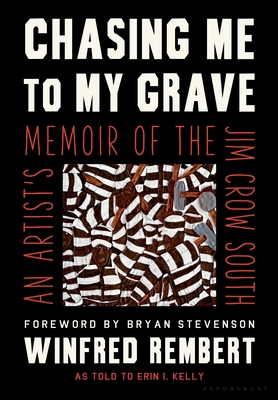[ad_1]
The artist Winfred Rembert accomplished unbelievable things in his seventy-five years, and he was the first to admit how unbelievable they seemed. But he wants you to know what drove him from picking cotton at age nine to being a local basketball star to surviving a lynching, working chain gangs, and gaining renown as a visual artist. He began making art at age 51, encouraged by his wife Patsy, by translating his experiences into colorful leather canvases filled with characters and scenes of black America that rarely make it into galleries.
To hear Rembert’s stories, read his memoir Chasing Me to My Grave: An Artist’s Memoir of the Jim Crow South. He wanted to write a book for years, but after meeting Erin I. Kelly, Professor of Philosophy at Tufts University, he found his scribe. Over the course of two years, he recounted the people and places of his life as she transcribed and edited them into the book, which also contains more than 75 full-color photographs of his paintings. His works are stunning contrasts of black faces in cotton fields and black and white prison striped figures on chain gangs. His works are vibrant and alive as well, especially those featuring red-dressed women swinging in front of jukeboxes, men in vests and bowler hats bent over pool tables, and blue clad policemen wielding billy clubs and dogs against two black men.
Rembert’s memoir is not just a lens through which we can view American history; at its heart it is a love story. His first great love was the woman who raised him, Lillian, whom he called Mama. She was actually his great-aunt. He never got a clear answer about his birth mother’s abandonment but attributed it to the fact that his birth father didn’t return from the army. His mother married another man whom she was ashamed to tell about her first marriage and son. Rembert tells the story of walking along a railroad for miles to meet her when he was nine years old and the police were after him, for what he couldn’t remember. They were always after him. When he got to his mother’s porch she didn’t invite him in. He depicted the story in a painting called “Looking for My Mother” in which a solitary brown boy climbs an insurmountable series of rails with a singular focus of moving forward. He writes, “I had mercy on her a little bit. Mercy is when you forgive people for what they’ve done, or for what you feel they’ve done. You say, well, I’m not going to hold that against them anymore.” In carving and painting leather he finds he can let go of the hurt of his mother’s desertion and move forward, too.
Another enduring love expressed in Rembert’s life story and paintings is his love of Cuthbert, Georgia where he grew up. His art and memoir speak to his fondness for the belonging the place forged among its black residents, from the doll’s head ball he and his friends played because they didn’t have baseballs to the cafes that hosted all-night dance competitions. Even more than place, the people made an impression on him. From the folks who hung out in the juke joints to barbershops that lined the main drag, “everything on Hamilton Avenue was black”. His first venture there was after he met a boy his age named Duck, who was also out of school, who took him to a pool hall. At the time Rembert had run away from Mama’s house to escape picking cotton and was sleeping in a nearby cemetery. He was good at pool and the owner of the hall hired him to collect balls and gave him a room to sleep in.
About Cuthbert, Rembert says “my mind goes in and around the town…Every person I do, I got a movie about them in my head. The movie plays and that starts me putting a character down on paper. I picture which positions to put him in, what I want him doing, and whether I want him looking mean or sorrowful or happy.” He liked spending time at Bubba Duke’s and Feet’s Pool Hall, named after the former basketball players who ran it, who held evening basketball tryouts where Rembert, who was left-handed, learned how to play ball. It was thanks to that early training he was able to impress the high school basketball coach who put him in school and gave him a place to stay. He liked to dance with a group of other boys, practicing steps on their front porches and going to the juke joints, eventually getting good enough to be regulars on a local television program called Rocking with the Deuce. “I think the reason Hamilton Avenue meant so much to me, in my youth goes back to the love part of my life. I mean, not receiving my mother’s love. I think my mother followed me in my mind, everywhere I went. I needed her love.”
Cuthbert was a place of safety and joy as long as Rembert avoided white folks, especially the policemen who were always after him. In the blacks-only part of downtown there was a restaurant owned by the Ku Klux Klan, which was known in the front by its Confederate flag, that served food through a hole in the back door. The town green housed the laughing barrel where any white person could command a black passerby to stick his or her head in a barrel and laugh at the white person’s joke. Refusing to participate in this public humiliation resulted in a six-week jail sentence that included cleaning the town. “They had a lot of six-week crimes in my hometown. Now what would you rather do, stick your head in a laughing barrel or go to jail for six weeks?” White people downtown would carry sticks or glass bottles and hit a passing black person without cause. There was little freedom from denigration and violence apart from Hamilton Avenue.
Rembert’s greatest love was for his wife Patsy, to whom he was married for fifty-six years. Tales of her weave in and out of the book, from the first time Rembert talked to her when he was working on a chain gang and her mother offered to feed him and the years of letter writing they shared before leaving Georgia and heading north for a better life. They ended up raising eight children in Connecticut on earnings from working on docks, construction, as a deacon of a church, and with help from the WIC program. Then a debilitating injury left Rembert with few options so he started running money for a drug dealer, eventually mixing and selling drugs himself. The law caught up with him. The judge in his case could tell he was different from the other men caught in the raid and showed him leniency so he could get back to raising his sons and keeping them away from drugs. He never went to jail again.
Chasing Me To My Grave documents racial and economic violence under white supremacy as a living history. It also gives us an example of how to live without bitterness or seeking revenge. From Rembert’s abandonment by his birth mother to the forced labor on the cotton fields and the abuses of the prison wardens, he remembers his struggle with acceptance, forgiveness, and often gratitude for the lessons he learned from his mistakes.
Rembert’s desire to tell his story in a white world that wanted him quiet and subservient, and sometimes wanted him dead, followed him to his grave. He passed away on March 31st of this year before seeing his memoir published. He was never going to outrun his blackness in Jim Crow or even in post-Civil Rights America, in the South or the North. Instead, he picked up some tools and paints and changed the arc of his story, placing black history at the center of it, transforming hate and humiliation into love and forgiveness.

Nonfiction
Chasing Me to My Grave: An Artist’s Memoir of the Jim Crow South
By Winfred Rembert as told to Erin I. Kelly
Bloomsbury Publishing
Published September 7, 2021

[ad_2]
Source link
